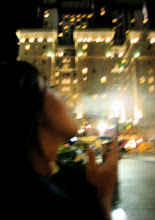When my friend Adlyn, owner of Hias Gourmet, the culinary tour company that I've talked so much about, asked me to join her on a foodie test tour through Sichuan, I jumped for joy. And got stuck. (R Peters shout out!) We were in a cab one night returning from a night market tour, when we began sharing early experiences with Chinese food. Mine was obviously of the red, hot and ma la type that is only found in Sichuan, evoking memories of strolls to the 'fly' restaurants ("cangying" aka. hole in the wall) down the street from my grandparents' place in Guanghan and ordering bowls of noodles sold by weight and smothered in sweet, spicy chilli sauce. These are some of the typical Sichuan xiaochi (snacks) that my childhood dreams were made of, and as I told Adlyn about them, a certain kind of crazy came over our eyes and like true addicts with excessive tendencies, we decided to indulge in a weekend of culinary hedonism in my favorite Chinese city.
The weekend started on Thursday night with an elaborate dinner at Baguobuyi, a Chengdu institution where we visited the back kitchen and watched the preparation of traditional Sichuan specialties like Huiguorou (spicy sliced pork fat) and Mapodoufu (spicy chilli tofu) in their industrial kitchens resplendent in steel and iron woks. The size and utility of the stations astounded me. There was no excess equipment, one wok and a large soup ladle did all of the work, only a combination of six spices were ever used, and each cooking station came complete with its own tap and sink. After a delicious meal, we wached a traditional face-changing show, which I am not surprised to report, works exactly how it sounds. Traditional clad dancers wore elaborate face masks that would change in rapid fire sequence at the nod of a head. Really, really neat.
The next day we went to the foremost culinary institute in China to learn a few dishes from one of the most sought after chefs in the country. No big deal.The chef showed us four core Sichuan dishes; Mapodoufu, Yuxiangqiezi (chilli braised egg plant), Shuizhuyu (hot pot fish), and Dandanmian (noodles in minced pork sauce), and afterwards we each got our own wok station and tried our hand at the dishes! I apparently need a few extra lessons because my tofu lacked colour and eggplant lacked flavour. And there you have the pillars of Sichuan cooking. It is all about the colour and the taste. You cannot have a dish without a lustrous coating of red oil on top and you cannot be satisfied until your taste buds are aburst with flavour and tongue numb from the spices. Most times these qualities are achieved at the expense of nutrition but 30 million people must be doing something right.
On another day, we drove out to the county of Pixian to visit the famous Pixiandouban (chilli bean condiment) factory, where factory operations consisted of a few hundred large clay pots filled with the black bean and chilli pepper concoction, fermenting happily in the sun. A sun-baked farmer walks through the rows of pots every hour or so with a large wooden stick, stirring the beans to make sure each batch receives equal exposure to the fiery heat. We all bought our obligatory vats of fresh chilli paste and got on our way to the next stop, the Sichuan Culinary Museum. This was a beautiful building that housed some ancient cooking equipment, illustrations and stories of traditional cooking from the time of the earliest inhabitants of the province, and culminating in a beautifully appointed dining room with a view into the kitchen where an army white hats prepared our lunch.
The pictures from the weekend are coming soon. And I promise they are decadent.
PS, you may have heard that Blogspot has been blocked in China, but red tape can't hold me down! byaahh!
5.25.2009
Subscribe to:
Post Comments (Atom)





No comments:
Post a Comment